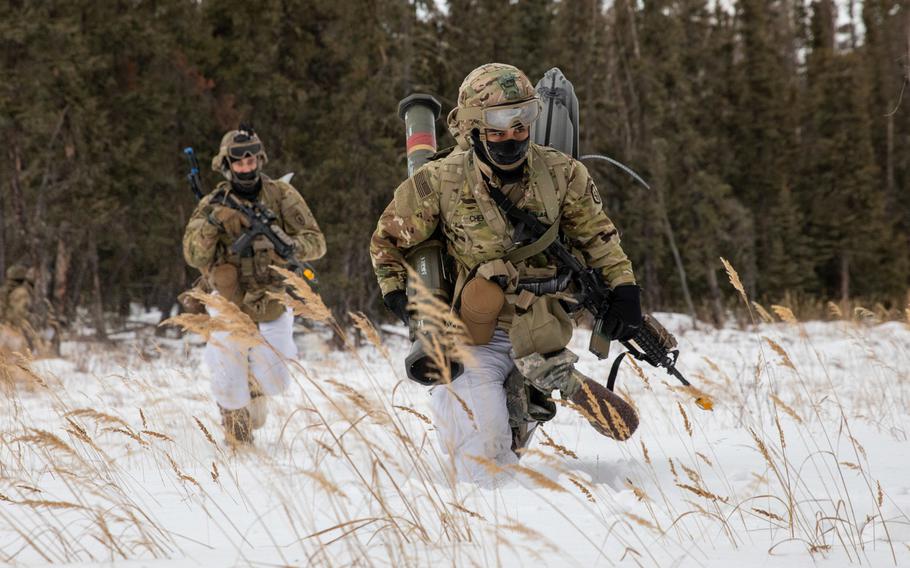
Paratroopers with 4th Infantry Brigade Combat Team (Airborne), 25th Infantry Division, cross a danger area during an assault exercise at Donnelley Training Area, Alaska, Feb. 11, 2021. Army scientists are looking into several methods for enhancing the ''thermal toughness'' of soldiers and making sure they don’t succumb to frostbite and hypothermia. (Alex Skripnichuk/U.S. Army)
Bodybuilding tourniquets and cocoa bean supplements could find their way into soldier toolkits as the Army looks for ways to keep troops warm in the Arctic, where the service expects more forces to be headed in the coming years.
“As an increasing number of Soldiers pour into the Arctic, it’s important that Army scientists ensure that Soldiers will have the biomedical solutions needed to fight and win in the frigid temperatures,” the U.S. Army Research Institute of Environmental Medicine said in a recent statement.
Army scientists are looking to enhance the “thermal toughness” of soldiers and make sure they don’t succumb to frostbite and hypothermia, the statement said.
The techniques go beyond just bundling up. To improve blood flow, the Army is examining a bodybuilding technique known as occlusion, which involves restricting blood flow with a tourniquet-style band while exercising.
The technique, popular among some weightlifters in search of a bigger biceps bulge, causes a burst of blood flow into the exercised muscle once the band is released.
John Castellani, a physiologist who leads Army research efforts in management of cold weather injuries and treatment, said recent studies have shown that occlusion training may increase normal blood flow. The Army is expected to investigate next year whether the technique can be used to improve hand function in cold weather.
The team is also examining the effect of a cocoa-based flavanol supplement, the Army said.
“The researchers are now testing if taking this supplement could increase blood flow to the hands and fingers, improving hand dexterity in the cold,” the Army said.
The work is part of a broader push by the service to update 2005 health guidelines on how soldiers should prepare for Arctic deployments and how to deal with cold-weather injuries.
“This is going to be a significant update to the Army’s medical guidance on cold weather,” Castellani said. “We are particularly focused on the treatment sections. We are also adding new guidance derived from significant data findings on performance in cold, wet environments, like swamps and bogs.”
The effort comes as the Army makes the Arctic more of a focus. In March, the service announced a new strategy for the High North, dubbed “Regaining Arctic Dominance.”
The plan calls for specially trained Arctic combat brigades and comes amid concerns that melting Arctic sea ice will lead to increased competition for resources. Russia has expanded military operations in the region, and China, which doesn’t border the Arctic, is seeking a foothold by calling itself a near-Arctic state.
In its 2018 Arctic policy document, Beijing said it has “rights in respect of scientific research, navigation, overflight, fishing, laying of submarine cables and pipelines in the high seas and other relevant sea areas in the Arctic Ocean,” and has “rights to resource exploration and exploitation.”
vandiver.john@stripes.com Twitter: @john_vandiver